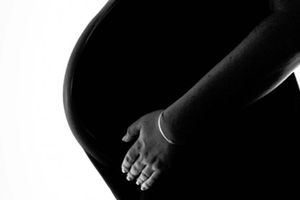‘How two ectopic pregnancies ended my motherhood dream’

Mary Kamwende during the interview on October 12, 2023.
What you need to know:
- An ectopic pregnancy occurs when a fertilised egg grows outside of the uterus. Almost all ectopic pregnancies, about 90 per cent, occur in the fallopian tube.
- As the embryo grows, it can cause the tube to burst (rupture). This rupture may lead to major internal bleeding. The development can be a life-threatening emergency that needs immediate surgery.
“The year was 2015 and I had just completed Form Four. I was 19 and naive. Then one day I started feeling quite sick. I had missed my period, but I was not alarmed. I thought it was merely hormonal changes. At the time, I had scanty information about pregnancy.
“Nausea and mood swings kicked in. Before I knew it, I had lost both my fallopian tubes. Now I will never be a mother. At least not through natural means,” says Mary Kamwende, 27.
This is the story of Mary, who, in a span of six years lost two pregnancies and both her fallopian tubes. Now she lives with the dark reality of potentially never becoming a mother.
For any woman who has had the privilege to carry life, the onset of a pregnancy has distinct signs. But to Mary, the signs were unlike anything she had experienced before. “My friend persuaded me to take a pregnancy test. The test confirmed my greatest fear. I was expectant,” she narrates.
Three months into the pregnancy, the worst happened. Mary recounts that she started experiencing intense abdominal pain accompanied by heavy vaginal bleeding. These and extreme light-headedness and general body pain.
She got alarmed and sought medical attention at a healthcare facility in Nairobi. It is at the facility that she would be diagnosed with ectopic pregnancy. She was as terrified as she was devastated, she says.
But what is an ectopic pregnancy?
According to the American College of Obstetricians and Gynecologist (ACOG), an ectopic pregnancy occurs when a fertilised egg grows outside of the uterus. Almost all ectopic pregnancies, about 90 per cent, occur in the fallopian tube, ACOG says.
As the embryo grows, it can cause the tube to burst (rupture). This rupture may lead to major internal bleeding. The development can be a life-threatening emergency that needs immediate surgery. This was Mary’s situation before she was referred to Kenyatta National Referral Hospital.
“A small incision was made in my abdomen near the navel. It was through this surgery that the ectopic pregnancy and the raptured tube were both removed. It was a traumatic experience,” she recounts.
In the ward during recovery, she would be spending time with other older women who had had similar experiences. “The women were sharing their experiences. I was lost in thoughts because this was my first pregnancy. The fact that I was a teenager did not help matters either.’’
While she was suffering in hospital, she also agonised about how to break the news to her parents. Thankfully, her doctor contacted her parents and briefed them on her condition.
But even more difficult for her was coming to terms with the loss of one of her fallopian tubes. Some of the people close to her began speaking behind her back, sending her into depression.
“I would spend most of the time alone, locked up in my bedroom. On the occasions I stepped out, I would be dressed in dark clothes, head covers and sweaters. I wanted to cover my body,” says the woman who had now become suicidal.
What specifically causes an ectopic pregnancy?
Dr Chadwink Ochieng says ectopic pregnancy occurs when a fertilised egg implants itself outside the uterus.
“The fertilised egg cannot survive outside the uterus and, if left to grow, it may damage nearby organs. This leads to a life-threatening loss of blood,” explains the doctor.
Common symptoms of ectopic pregnancy include pelvic pain and vaginal bleeding. In terms of prevalence, the doctor explains that ectopic pregnancies comprise about only two per cent of all pregnancies.
‘‘The condition is, however, the leading cause of pregnancy-related maternal death in the first trimester, usually due to lack of medical intervention,” Dr Ochieng says, adding that he attends to between 10 and 15 cases of ectopic pregnancy in a month. On some days, he can attend to up four cases in a day.
The doctor notes that about 90 per cent of ectopic pregnancies occur in the fallopian tube. Some, though, may manifest in the ovaries or the abdomen.
Based on his experience, Dr Ochieng says the use of emergency contraceptive pills such as postinor 2 (P2) is the primary cause of ectopic pregnancy.
“Many of the patients I have treated admit to having used P2. This emergency pill has the potential to reduce the movement of the fallopian tube. Abortion and other infections that result in the scarring of the tubes may also lead to ectopic pregnancy,” he observes.
‘‘When the tubes are partially blocked, this prevents the fertilised egg from reaching the uterus,’’ he says.
Expectant mothers who notice unusual bleeding or abnormal abdominal pain should seek medical attention, he says while recommending performance of an ultrasound within the first 12 weeks of pregnancy. This, he explains, is to ensure the embryo is developing in the right place.
For women using emergency contraceptives, he advises moderation. This means using them only twice a year.
Dr Ochieng warns that women who have experienced ectopic pregnancy before have a higher likelihood of experiencing it again. ACOG concurs. This was Mary’s discovery six years later when in 2021, she had a second ectopic pregnancy.
This time round it was not a mystery to her. As a young woman, Mary had nurtured the dream of becoming a mother one day. She had already lost one fallopian tube. The second one had to be removed. This would leave her with no conventional path to motherhood. Now this dream was entangled in the inevitable complexities of her own body.
“I was back in the theatre for a second surgery after three months of pregnancy. Against all odds, the foetus was still clinging to life. I could feel its feeble heartbeat. Yet I had to sacrifice its life for my safety. For me to live. This was a heartbreaking moment. I cried,” she recalls with a shiver.
Not all ectopic pregnancies require surgery, the doctor notes. But this comes with a caveat. ‘‘When detected early, there are medications available as an alternative treatment.”
In her pain and loss, however, Mary says she was comforted by the fact that she had cradled the preciousness of human life in her. Even so, she was too traumatised to fully comprehend the extent of her experience. It is through hindsight now that she has recognised the profound pain she had endured.
“It really affected me. ‘‘Most of the time I felt like a walking corpse. I was weighed down by my past. It was an arduous battle,’’ she narrates, her voice a tapestry of strength and vulnerability.
Alongside the irreversible physical transformation came self-doubt. Mary grappled with an internal conflict, questioning her worth.
While some murmured about her situation, others offered solace, assuring her that she would bear children at the right time. Only they did not understand her condition. Or grasp the depth of her anguish from this reproductive health nightmare that loomed like an insurmountable wall.
Now staring at a childless future, Mary made the courageous choice to face her fate. By putting her safety first. She went for counselling and then saw a gynaecologist.
To reclaim her life, she started to pay close attention to her emotional well-being, physical health and spirituality. By setting goals on these parametres and keeping a strict medical routine, things started to look up in her life, she says.
“It was in those moments of clarity that I finally began to unravel the mystery of my past experiences. This was the beginning of my healing journey,’’ she notes, sighing with relief.
Her new lifestyle came with difficult choices too, including giving away parts of her that she was intimately connected to. She explains: “The hardest decision I made in my transition had a direct bearing on my sexuality. As a young woman, I had a high sex drive. The decision to abstain was like attempting to withdraw from an addiction.’’ But resolute about change, she held on.
She also found solace in spirituality. On this front, she delved into books to deepen her connection with God, including through prayer. “It has been a therapeutic journey. I have since developed a keen interest in storytelling. I enjoy crafting stories and listening to people share theirs. This has renewed my strength and creativity,” Mary says.
If detected early, an ectopic pregnancy is treatable. One way to treat it is through medication. The alternative is surgery. The most common drug used to treat an ectopic pregnancy is methotrexate, according to ACOG. This drug stops cells from multiplying, thus ending the pregnancy. The pregnancy is absorbed by the body over a period of between four and six weeks. In this case, the fallopian tube is not removed.
Mary says administering methotrexate was not possible in her case. The two pregnancies had extensively ruptured her fallopian tubes, making them unsalvageable. They both had to be removed.
Several factors are considered before using methotrexate, as outlined by ACOG. One of the most important factors is an individual’s ability to follow up with blood tests to check blood levels of hCG (hormones made by the placenta when one is expectant). Secondly, lactating mothers are not allowed to use methotrexate.
It is now two years since Mary’s second surgery and she’s well on her recovery path. “I thank God I did not execute the suicidal thoughts I had,’’ she reflects, noting that she has since been able to embrace herself.
One of Mary’s audiences is a deaf community she has been educating about sexual reproductive health. Her motivation? ‘‘The recognition that people with disabilities often lack access to comprehensive reproductive health information,’’ she says, adding that she enrolled in sign language education to ensure inclusivity in her endeavour.
Besides the deaf community, the young woman provides support to women who have experienced ectopic pregnancies. “I embarked on this journey out of the recognition that everyone needs comprehensive sexual health education.’’
She advises both unmarried and married women to routinely see a doctor to enhance awareness of their health and overall well-being.
“My fallopian tubes had to be removed due to late detection of my ectopic pregnancies. Women can avoid this situation by proactively seeking medical attention,’’ she says.
Her biggest acceptance has been the fact that she cannot conceive naturally. If she decides to have children, however, she would have to undergo in-vitro fertilisation (IVF). This is one of the technologies that help women with fertility challenges to have a baby.
During IVF, an egg is removed from the woman’s ovaries and fertilised with a sperm in a laboratory. Also called an embryo, the fertilised egg is then implanted in the woman’s womb (uterus) to develop.
“While I will not bear children through natural means, I am thankful for technology. I believe that my journey was meant to shape me into a pillar of strength for other women who find themselves navigating similar challenges like I did in life,’’ she tells Healthy Nation.
Despite not being fully healed, Mary says she is far from where she began. ‘‘As a mentor to others, I have had to keep my head high. I have made significant progress. It has not been an easy road. It started with shifting from blame to acceptance. This was a pivotal turning point for me.’’





